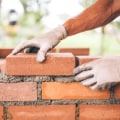Introduction: The Evolution of Masonry Finishes
Masonry, a discipline rooted in strength and structure, has long been associated with traditional materials like brick, stone, and concrete. Historically valued for their durability and load-bearing qualities, these materials are now being reimagined through a modern design lens—especially when it comes to finishing techniques.
One striking trend redefining masonry finishes is minimalism. What was once hidden beneath carpet or tile is now being polished, exposed, and celebrated for its raw, refined beauty. At the heart of this transformation is a material that bridges tradition and innovation: polished concrete.
Minimalism Meets Masonry
Minimalism in architecture and design emphasizes simplicity, clean lines, and a focus on function over embellishment. In masonry, this movement has brought a new aesthetic approach to how walls, floors, and surfaces are treated:
Exposed brickwork is being retained in both residential and commercial projects for its rustic appeal.
Natural stone finishes are left unpainted or honed for a sleek, organic appearance.
And most notably, concrete floors are no longer covered—they are polished to a mirror-like sheen that enhances their structure while delivering modern elegance.
Polished Concrete: A Contemporary Masonry Marvel
Among all minimalist finish options, polished concrete stands out for its ability to combine aesthetics, performance, and sustainability. What was once considered a utilitarian material used mainly in industrial settings is now central to high-end residential and commercial interiors.
This finishing technique involves grinding and sealing concrete surfaces to expose the aggregates within, then refining them to a smooth, high-gloss finish. The result is a surface that’s:
Highly durable and resistant to wear
Low-maintenance compared to traditional flooring
Thermally efficient, absorbing and retaining heat
Visually striking, especially in spaces that value open layouts and light reflection
One standout resource that explores this shift in detail is the article Modern Meets Minimal: Why Polished Concrete Is the Ultimate Trend, which highlights how polished concrete has moved from industrial flooring to a design-forward choice in contemporary architecture.
Sustainability and Performance Advantages
Aside from its aesthetic appeal, polished concrete aligns with broader goals in sustainable masonry construction. By using the existing concrete slab as the finished floor, it eliminates the need for additional materials like vinyl, tile, or carpet—reducing both waste and embodied energy.
Additionally, the longevity of a polished concrete floor can exceed decades with proper care, making it a cost-effective solution in the long term.
Applications Across Masonry Projects
Minimalist masonry finishes, especially polished concrete, are being adopted in a wide range of project types:
Residential homes, where homeowners seek seamless, modern aesthetics with low maintenance.
Commercial spaces, such as showrooms and offices, where durability and design must coexist.
Institutional buildings, including schools and hospitals, that benefit from easy-to-clean, high-performance surfaces.
These finishes complement other masonry elements, such as exposed concrete walls, stone cladding, and brick veneers—creating a cohesive and minimal design language.
Conclusion: The Future is Refined, Not Rough
As the lines between structural and aesthetic elements continue to blur, the masonry industry is embracing finishes that enhance both form and function. From brick to gloss, the shift toward minimalist surfaces reflects a broader cultural movement: one that values authenticity, efficiency, and the natural beauty of materials.
Polished concrete is not just a surface treatment—it’s a symbol of how masonry can evolve to meet the demands of modern design.







